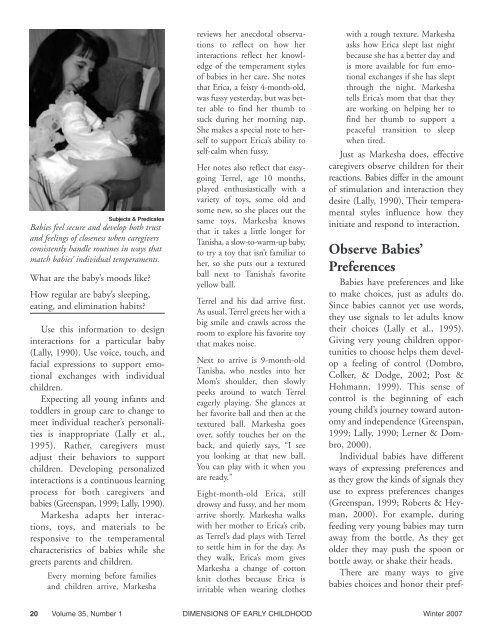Dimensions of Early Childhood - Southern Early Childhood ...
Dimensions of Early Childhood - Southern Early Childhood ...
Dimensions of Early Childhood - Southern Early Childhood ...
Create successful ePaper yourself
Turn your PDF publications into a flip-book with our unique Google optimized e-Paper software.
Subjects & Predicates<br />
Babies feel secure and develop both trust<br />
and feelings <strong>of</strong> closeness when caregivers<br />
consistently handle routines in ways that<br />
match babies’ individual temperaments.<br />
What are the baby’s moods like?<br />
How regular are baby’s sleeping,<br />
eating, and elimination habits?<br />
Use this information to design<br />
interactions for a particular baby<br />
(Lally, 1990). Use voice, touch, and<br />
facial expressions to support emotional<br />
exchanges with individual<br />
children.<br />
Expecting all young infants and<br />
toddlers in group care to change to<br />
meet individual teacher’s personalities<br />
is inappropriate (Lally et al.,<br />
1995). Rather, caregivers must<br />
adjust their behaviors to support<br />
children. Developing personalized<br />
interactions is a continuous learning<br />
process for both caregivers and<br />
babies (Greenspan, 1999; Lally, 1990).<br />
Markesha adapts her interactions,<br />
toys, and materials to be<br />
responsive to the temperamental<br />
characteristics <strong>of</strong> babies while she<br />
greets parents and children.<br />
Every morning before families<br />
and children arrive, Markesha<br />
reviews her anecdotal observations<br />
to reflect on how her<br />
interactions reflect her knowledge<br />
<strong>of</strong> the temperament styles<br />
<strong>of</strong> babies in her care. She notes<br />
that Erica, a feisty 4-month-old,<br />
was fussy yesterday, but was better<br />
able to find her thumb to<br />
suck during her morning nap.<br />
She makes a special note to herself<br />
to support Erica’s ability to<br />
self-calm when fussy.<br />
Her notes also reflect that easygoing<br />
Terrel, age 10 months,<br />
played enthusiastically with a<br />
variety <strong>of</strong> toys, some old and<br />
some new, so she places out the<br />
same toys. Markesha knows<br />
that it takes a little longer for<br />
Tanisha, a slow-to-warm-up baby,<br />
to try a toy that isn’t familiar to<br />
her, so she puts out a textured<br />
ball next to Tanisha’s favorite<br />
yellow ball.<br />
Terrel and his dad arrive first.<br />
As usual, Terrel greets her with a<br />
big smile and crawls across the<br />
room to explore his favorite toy<br />
that makes noise.<br />
Next to arrive is 9-month-old<br />
Tanisha, who nestles into her<br />
Mom’s shoulder, then slowly<br />
peeks around to watch Terrel<br />
eagerly playing. She glances at<br />
her favorite ball and then at the<br />
textured ball. Markesha goes<br />
over, s<strong>of</strong>tly touches her on the<br />
back, and quietly says, “I see<br />
you looking at that new ball.<br />
You can play with it when you<br />
are ready.”<br />
Eight-month-old Erica, still<br />
drowsy and fussy, and her mom<br />
arrive shortly. Markesha walks<br />
with her mother to Erica’s crib,<br />
as Terrel’s dad plays with Terrel<br />
to settle him in for the day. As<br />
they walk, Erica’s mom gives<br />
Markesha a change <strong>of</strong> cotton<br />
knit clothes because Erica is<br />
irritable when wearing clothes<br />
with a rough texture. Markesha<br />
asks how Erica slept last night<br />
because she has a better day and<br />
is more available for fun emotional<br />
exchanges if she has slept<br />
through the night. Markesha<br />
tells Erica’s mom that that they<br />
are working on helping her to<br />
find her thumb to support a<br />
peaceful transition to sleep<br />
when tired.<br />
Just as Markesha does, effective<br />
caregivers observe children for their<br />
reactions. Babies differ in the amount<br />
<strong>of</strong> stimulation and interaction they<br />
desire (Lally, 1990). Their temperamental<br />
styles influence how they<br />
initiate and respond to interaction.<br />
Observe Babies’<br />
Preferences<br />
Babies have preferences and like<br />
to make choices, just as adults do.<br />
Since babies cannot yet use words,<br />
they use signals to let adults know<br />
their choices (Lally et al., 1995).<br />
Giving very young children opportunities<br />
to choose helps them develop<br />
a feeling <strong>of</strong> control (Dombro,<br />
Colker, & Dodge, 2002; Post &<br />
Hohmann, 1999). This sense <strong>of</strong><br />
control is the beginning <strong>of</strong> each<br />
young child’s journey toward autonomy<br />
and independence (Greenspan,<br />
1999; Lally, 1990; Lerner & Dombro,<br />
2000).<br />
Individual babies have different<br />
ways <strong>of</strong> expressing preferences and<br />
as they grow the kinds <strong>of</strong> signals they<br />
use to express preferences changes<br />
(Greenspan, 1999; Roberts & Heyman,<br />
2000). For example, during<br />
feeding very young babies may turn<br />
away from the bottle. As they get<br />
older they may push the spoon or<br />
bottle away, or shake their heads.<br />
There are many ways to give<br />
babies choices and honor their pref-<br />
20 Volume 35, Number 1 DIMENSIONS OF EARLY CHILDHOOD Winter 2007

















